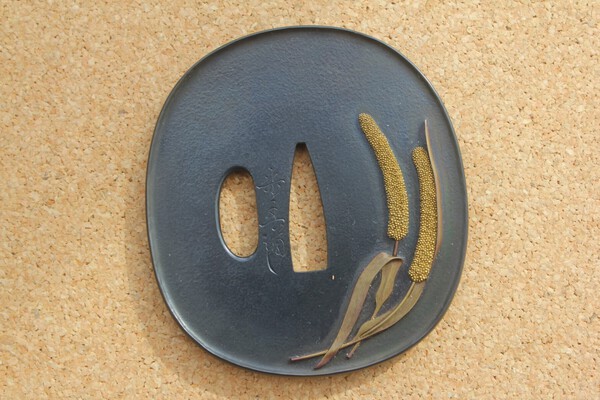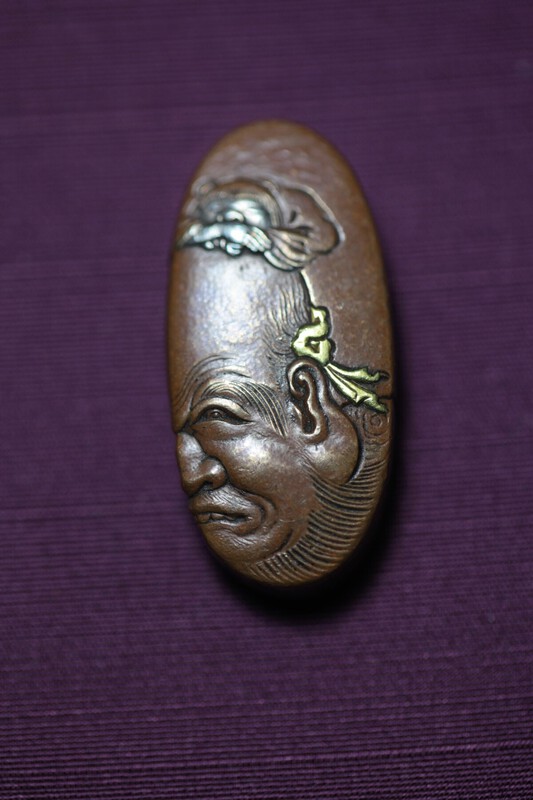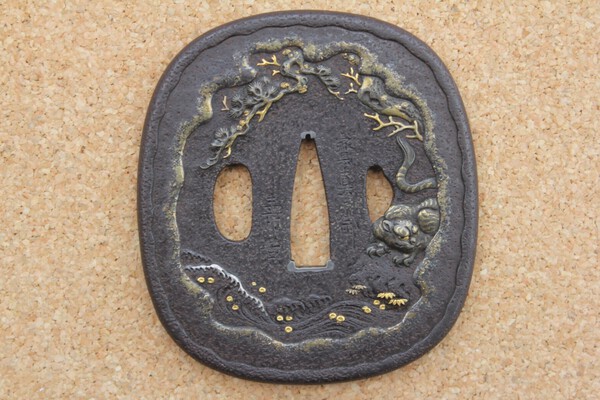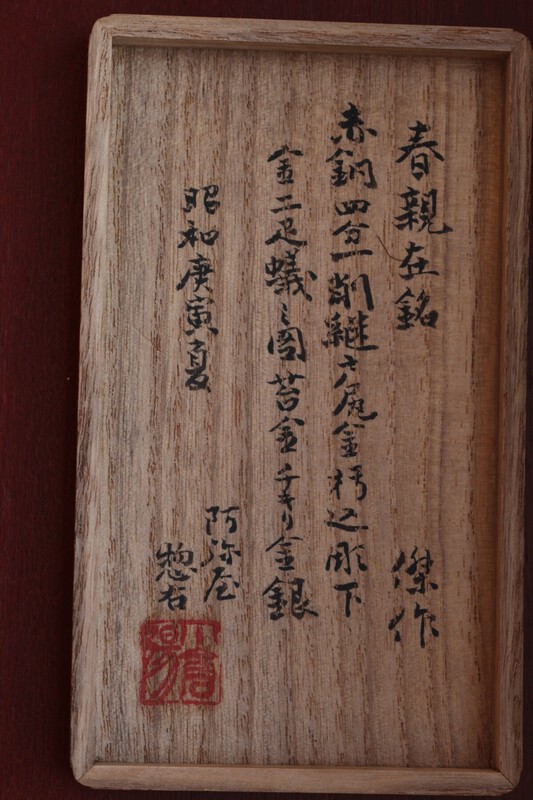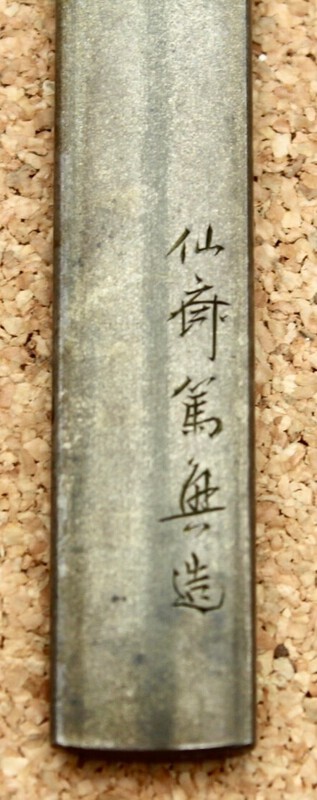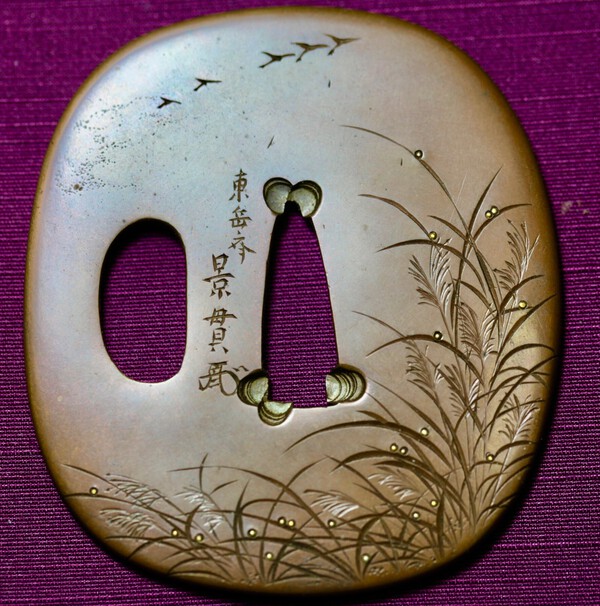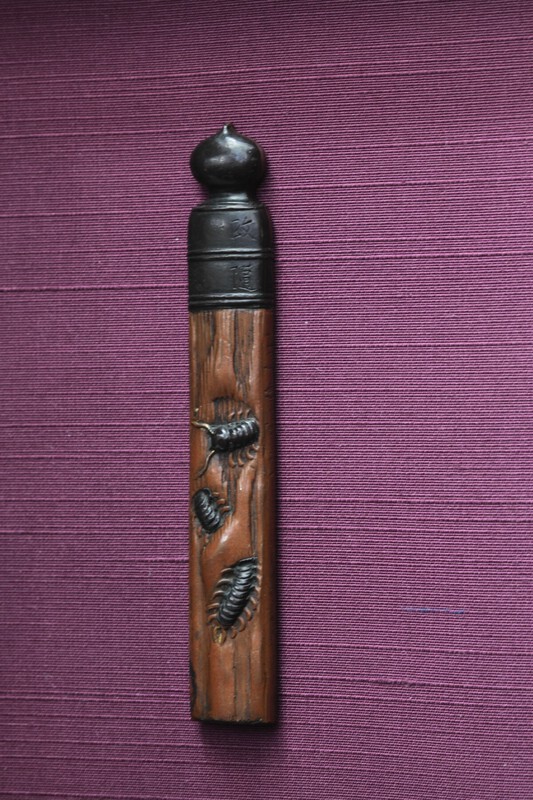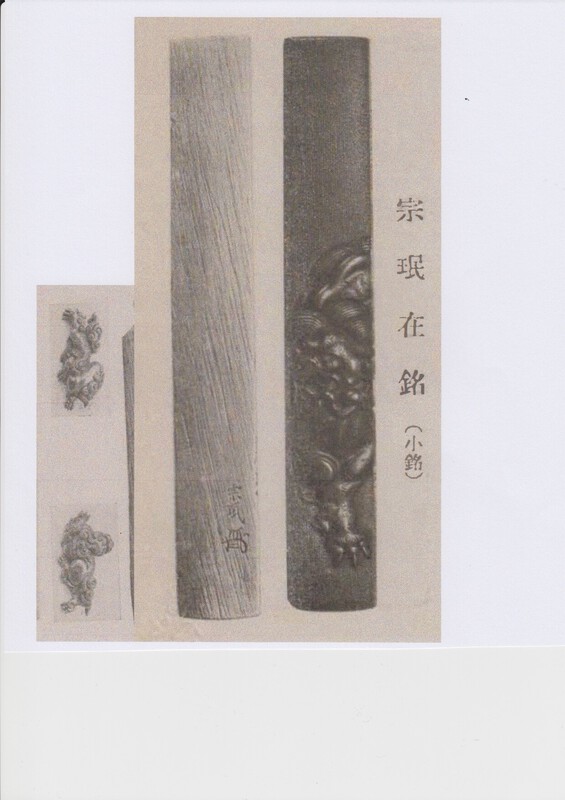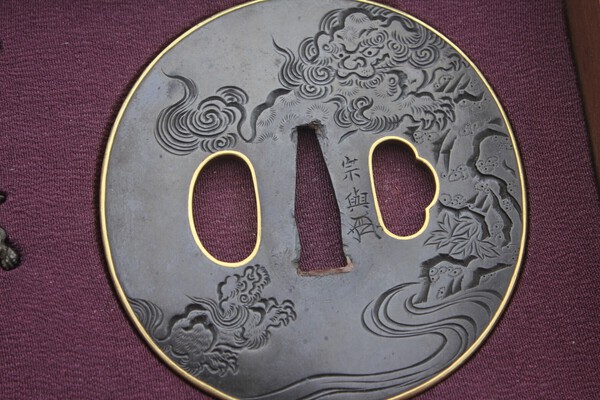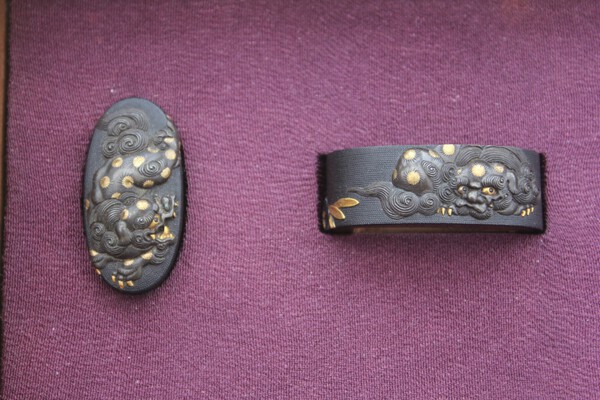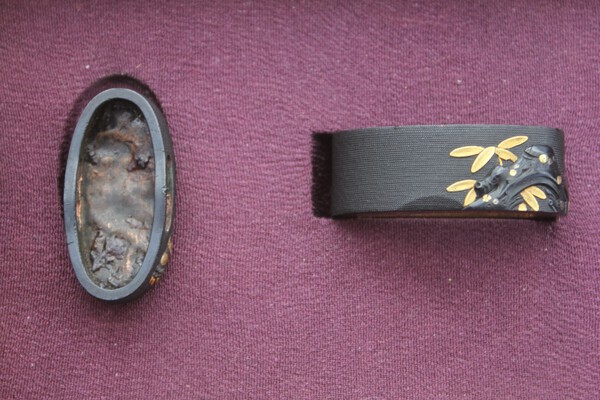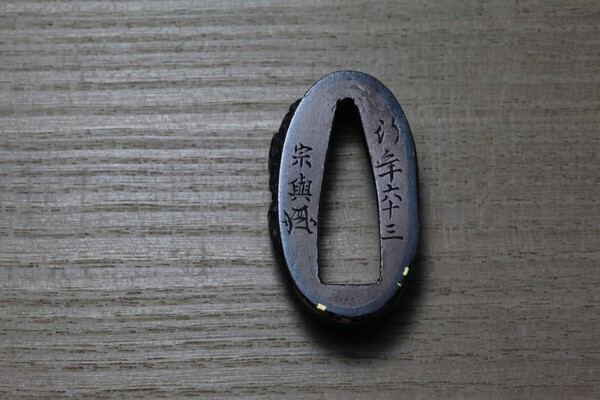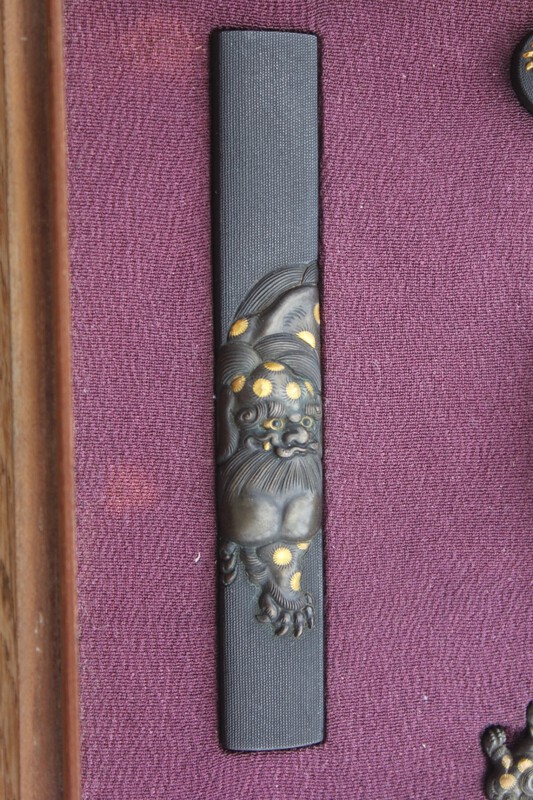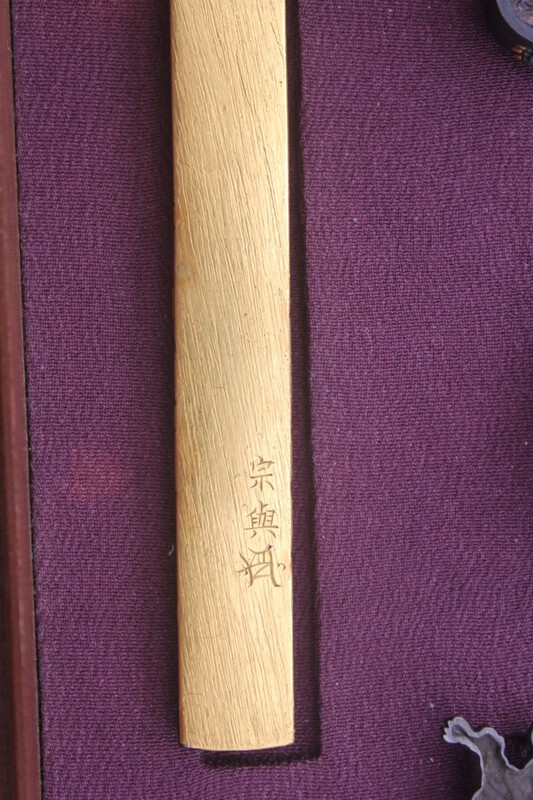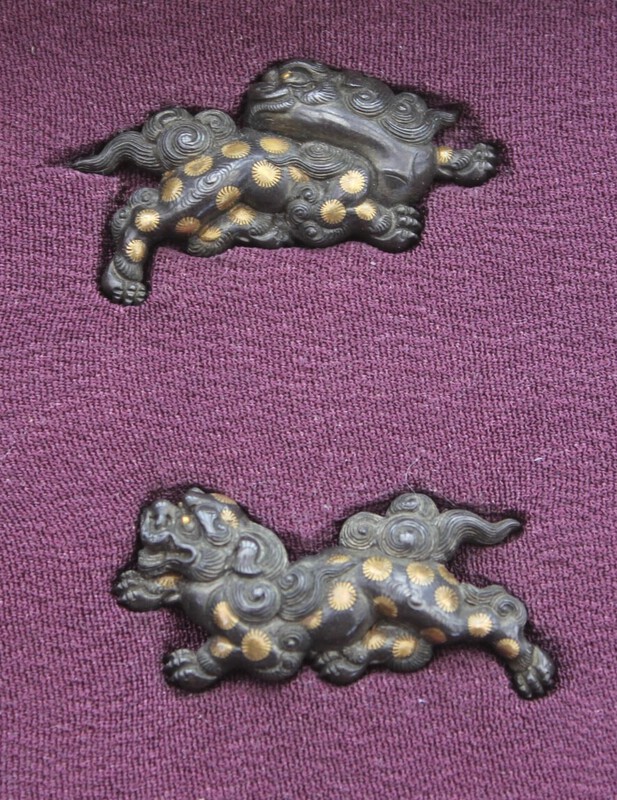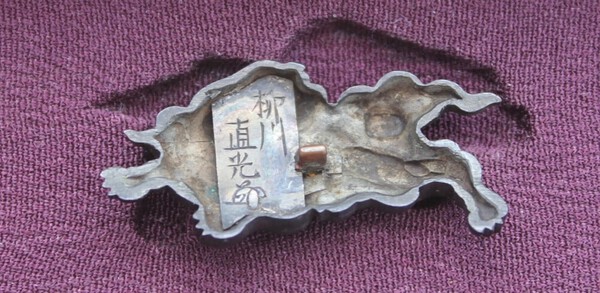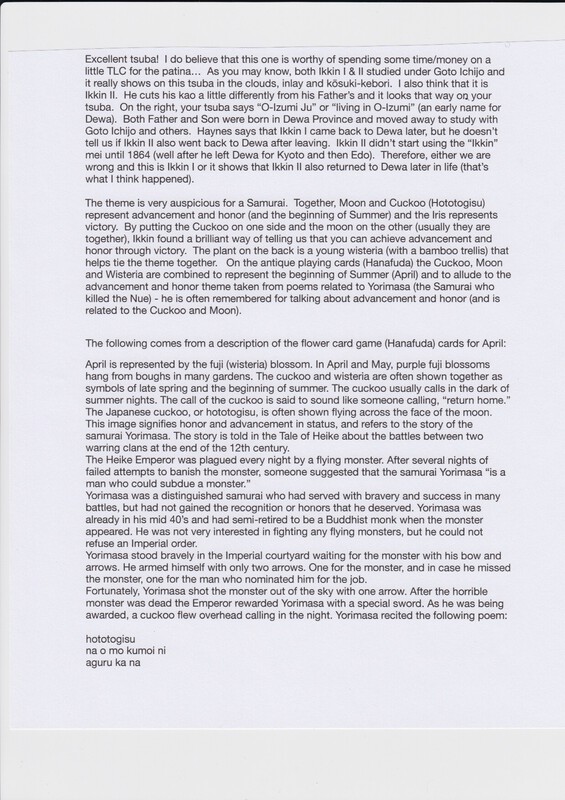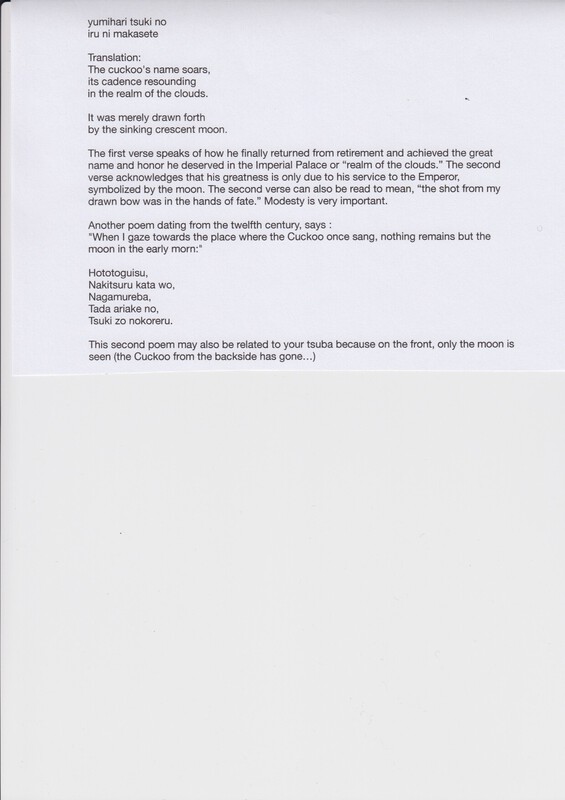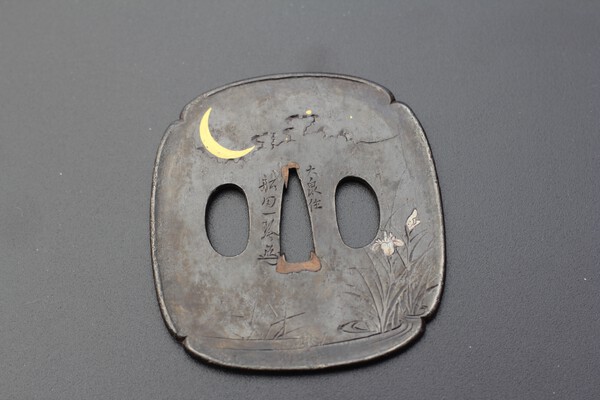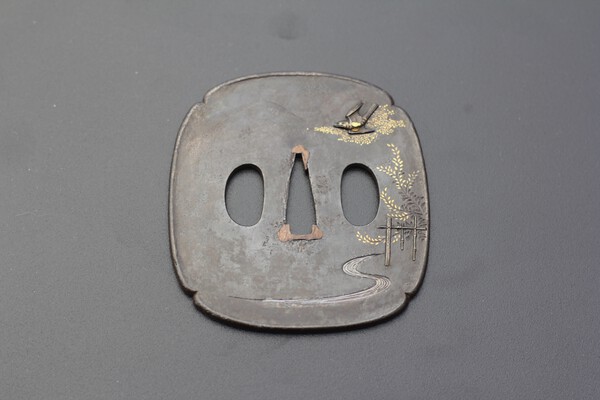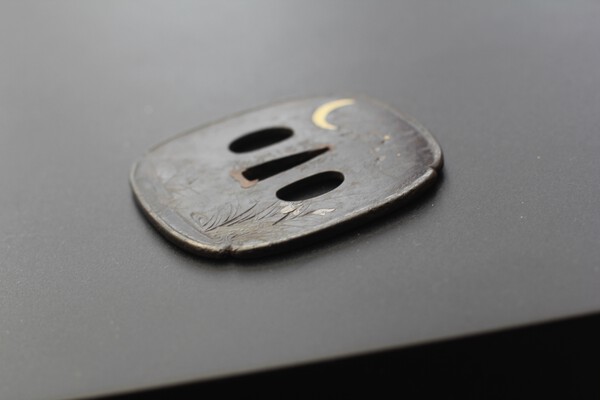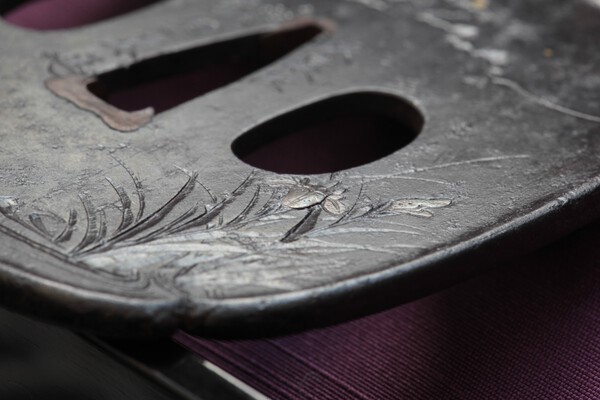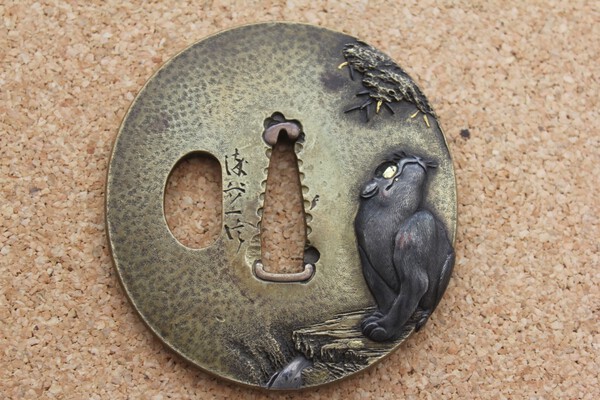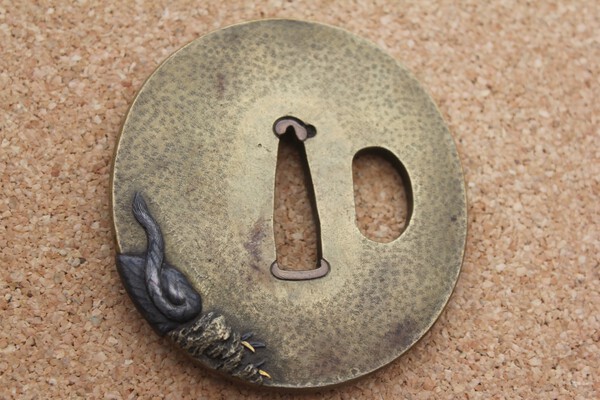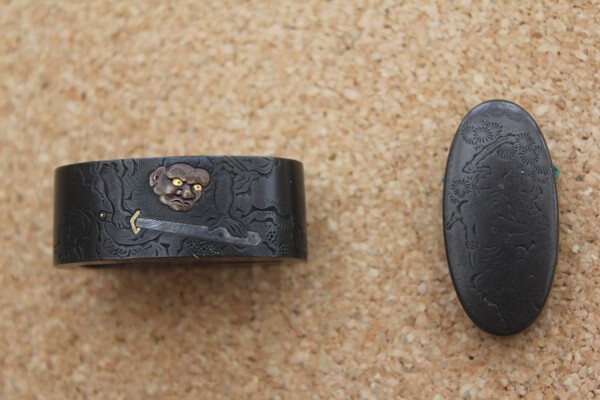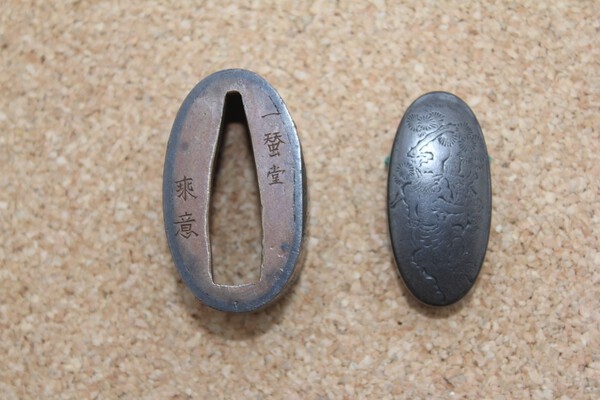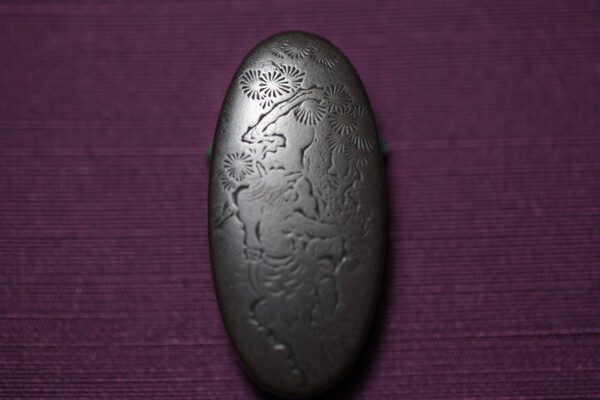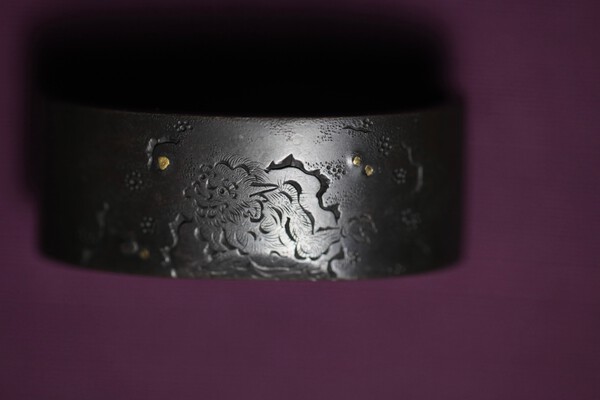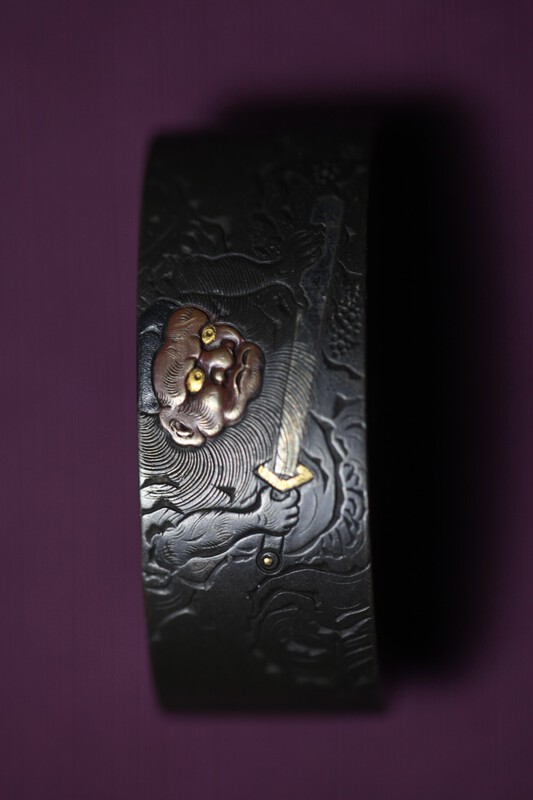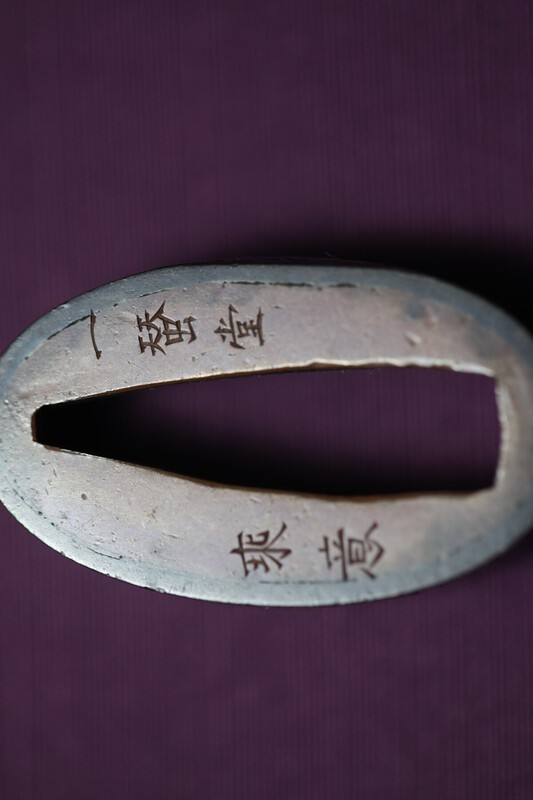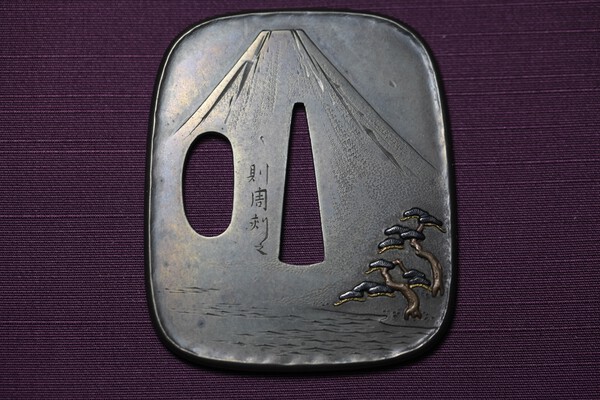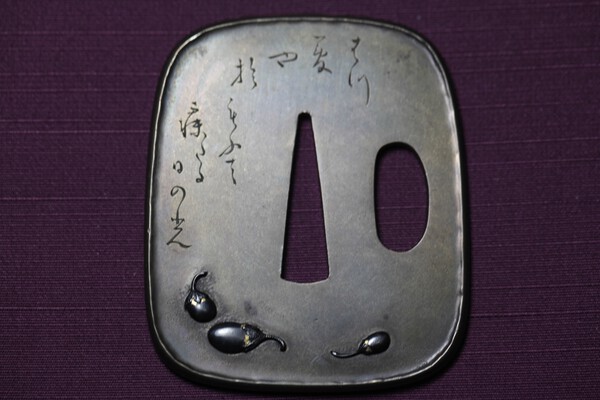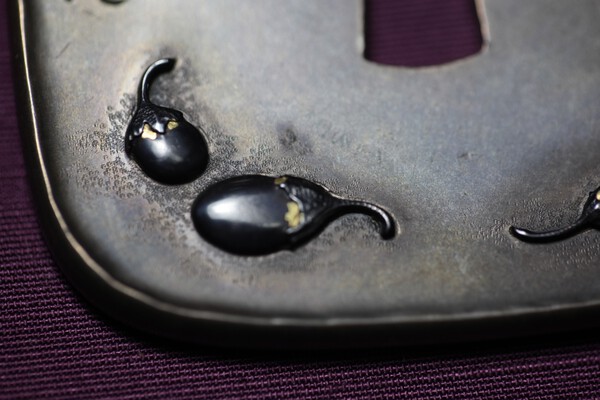-
Posts
614 -
Joined
-
Last visited
-
Days Won
25
Content Type
Profiles
Forums
Events
Store
Downloads
Gallery
Everything posted by Bob M.
-
Item No. 304 Tsuba in shakudo with gold 8.00 cm x 7.33 cm x 0.39 cm Subject of ripe millet stalks and heads by Ford Hallam - 2011. A commissioned tsuba featuring in the documentary film ' Yugen '. Although without verbal commentary, Yugen does illustrate thought processes as well as manufacturing technique in the production of a masterpiece. Links to the film through this section of the Message Board ( above ) or through Ford Hallam's You Tube channel.
- 954 replies
-
- 10
-

-

-
Re. Item No. 303 As mentioned above, the following commentary is received from George Miller with Many Thanks. ' Fukurokuju and Karako. Fukurokuju is one of the Seven Gods of Good Fortune. His name is made up of 'fuku' (happiness), 'roku' (wealth) and 'ju' (longevity). He carries a scroll that has everyone's lifespan in it and is said to be the only god who can resurrect the dead. Karako is the generic name for small children depicted on tosogu in Chinese garb (kara=China and ko=small or child). Fukurokuju is often confused with Jurojin - both have elongated heads. Some sources say that you can tell the two apart by the implements that they carry, and Jurojin carries a Chinese fan (like the one that the boy is playing with on your fuchi), but I have also seen Fukurokuju with that kind of fan. I think that the look on Fukurokuju's face (and sleeping Karako on his head) on the kashira and the Karako using his magic fan to chase butterflies away on the fuchi allude to Rosei's Dream. Rosei's Dream is a famous motif in Japanese art about a guy who dreams of great success (happiness, wealth and longevity). He is depicted in Japanese art with a Chinese fan (like the Karako is using on your fuchi) and butterflies flying around his head as he sleeps. I think that your Fukurokuju is upset that the Karako is chasing away the dreams of success that Fukurokuju represents. ' As usual, a fascinating back story that is hidden within the fittings and brought into the light for our education... Thanks again, George !
-
Item No. 303 Fuchi Kashira in copper with gold and silver. Subject of Fukurokuju being annoyed by some Karako . Signed by Joi ( Nara School ) 19th Cent. Crafted with great attention to detail , the face of the god is particularly expressive and is carved in 3d , wrapping around the side of the fuchi. I should be able to post some background information in the next few days , courtesy of George Miller.
-
Re Item No. 302 George Miller has sent through the following contribution to this item regarding the positioning and style of the kao. ' My guess is that the kao on the back is a ' stamp of approval ' by Kiyotoshi of his student's work or a joint effort ( and that's why it is a combination of the two artist's kao and on the back ). I haven't see this written about anywhere for Kiyotoshi, but it would make sense to me about why the kao is on the back. ' Many Thanks, George. Any thoughts or comments on this from anyone ?
-
Item No. 302 Tsuba in Iron with gold, shakudo and shibuichi 7.54 cm x 6.85 cm x 0.43 cm Subject of Tiger with pine trees and crashing waves by Hoshinsai Toshikage ( Haynes 10383 ) Toshikage was a student of Tanaka Kiyotoshi and therefore worked in the Tanaka style. Beautifully crafted with a lot of fine detail.
-

Peter Yorke RIP.
Bob M. replied to charlesf's topic in Sword Shows, Events, Community News and Legislation Issues
RIP Peter , do yourself some great deals in Nihonto heaven. I used to do a bit of business from time to time with him - sadly, another Character exits the Play... Bob -
Re Item No. 301 The placement of the moss might also be an indicator as it only appears on the shakudo ( representing older ? ) bark/wood.
-
Item No. 301 Kozuka in Shakudo , Shibuichi and Gold Subject of ants on bark , signed Haruchika , 19th cent. Made in two separate sections of Shakudo and Shibuichi, joined with Gold clips and a dovetail joint, ants are inlaid onto a bark texture ground. A pleasing, unusual piece which also has an attestation by Amiya Soemon on the interior of the box lid. Can anyone help with the translation please ?
-
Item No. 300 Kozuka in shibuichi with gold Subject of a tiger glowering beneath stormy skies . A naturalistic rendition of the subject by Sasayama Tokuoki ( 1813 - 1891 )of the Otsuki School in Kyoto. The lightning bolt rendered in typical School fashion. A Masterful carving in katakiri from the end of the Edo period.
-
Item no. 299 Tsuba in yamagane with gold 6.15 cm x 5.54 cm x 0.35 cm Subject of autumn scene signed Togakusai Keikan & kao, can anyone find a reference to this artist ? This is truly one of my favourite pieces - although small and bearing a simple design , it is a tour de force of the carvers art. When viewed deeply or held in hand , it is easy to imagine yourself on the Musashi Plain or by a water margin . The day is crisp with the promise of winter to come and the Silver Grass is just on the edge of dying down . The geese are returning in skeins and their calls add to the feeling of fading seasons... It may only be a tsuba for a tanto but in my view it is a sublime and evocative piece in the best tradition of Japanese Art. The tsuba was so dirty and discoloured that the dealer I bought it off, some ten years ago, thought it to be Shakudo. Some TLC from Ford Hallam changed all that. I will try and dig out some old pictures for a before and after comparison.
- 954 replies
-
- 13
-

-

-
Re. Item No. 298 Thanks once again are due to George Miller for the information below and background to this piece. ' The motif is very interesting and is allegory for proper Samurai behavior that comes from an actual historical event. Fujiwara no Hidesato (aka Tawara Toda) was a famous Samurai from the Heian Period who helped quell the revolt of Taira no Masakado who had declared himself royalty in opposition to the Emperor. Hidesato had met Masakado before and had deemed him to be a bad Samurai from some fairly minor transgression of eating food off the floor (shows you should always have good table manners…) Masakado knew Hidesato was coming after him and he knew of Hidesato’s prowess with a bow, so he employed many doubles who dressed like him to try to avoid being shot by Hidesato. Hidesato ended up cutting off Masakado’s head and was given many rewards for his valor in that battle. There is a famous legend about Hidesato (also know as Tawara Toda or “My Lord Bag of Rice”) meeting the Dragon King (or his daughter) on the Seta Bridge and agreeing to help the Dragon King by killing a giant centipede that had been plaguing his family. Many scholars believe that the centipede legend is an allegory for Hidesato’s action in killing Masakado on behalf of the rulers in Kyoto. As the legend goes: Hidesato was walking across Setagawa bridge and saw a huge dragon laying across it. Being courageous, Hidesato simply climbed over the dragon’s back and continued on his way. Then he heard a voice calling to him from behind and turn to discover a feeble old man dressed like a king with a dragon crown. It turned out to be Ryujin the King of the Sea (who represents the Emperor in this allegory). Ryujin explained that he had been laying across the bridge for a long time waiting for someone courageous enough to walk over him because he needed an exceptional warrior to kill a giant centipede (which represents Masakado and his army) that had been eating his family members one-by-one. Apparently dragons are only afraid of centipedes (and five colored cloth - but that’s a story for another time…) Hidesato immediately agreed to help Ryujin and kill the giant centipede. The giant centipede (omukade in Japanese) was coiled around Mount Mikami (the image of the centipede wrapped several times around a mountain represents the many Masakado troops filing down the road that spirals down the mountain). Hidesato only had three arrows and the first two that he shot simply bounced off the centipede’s exoskeleton. Then Hidesato remembered that human spit is poisonous to centipedes… so he licked his last arrow and let it fly - hitting the Giant Centipede in the forehead and killing it instantly. Ryujin was delighted and insisted that Hidesato accept many gifts and rewards including and inexhaustible bag of rice (where Hidesato gets his nickname My Lord Bag of Rice) and the Bell of Miidera (which features in several other legends - like Benkei). The story demonstrats proper Samurai behavior - helping the weak without asking for reward, being courageous, etc. Tosogu artists refer to this legend in several different ways, sometimes with a bridge post and centipede, sometimes with Hidesato speaking with the Dragon King (or the Dragon King’s daughter in other versions). Your kozuka has the added treat of Hidesato’s famous bow in kebori on the back. '
-
Item No. 298 Kozuka in copper , shibuichi , shakudo and gold Subject of the Bridge Post of Seta with centipede signed Masayuki. Interesting fitting recently purchased at auction. The signature is likely gimei -( can be read shozui ) but an unusual subject nontheless. The back story to this is being researched and I hope to be able to add the information in the next few days. The kozuka has been in the United Kingdom for well in excess of a hundred years - auctioned 23rd November 1910 Glendinings lot 107 ( part ).
-
Re. Items 294 - 297 Many Thanks to George Miller for the following research and commentary on this set.
-
Item No. 297 Tsuba in Shakudo with gilt 8.00 cm x 7.85 cm x 0.36 cm Subject of Shishi and cub with peonies and stream signed Soyo with kao Together with the three previous items makes up the Yokoya Soyo/ Yanagawa Naomitsu set of fittings. High quality workmanship in katakiri and kebori on the theme of a Shishi testing its cub. NBTHK papered.
-
Item No. 296 Fuchi Kashira in Shakudo with Shibuichi and Gold Subject of Shishi , from the same set as the two previous items. signed Gyonen rokuju-san , Soyo with kao ( at the age of 63 ) Another pair of dynamic Shishi images, this time displayed on a fine nanako ground of a Fuchi Kashira. NBTHK papered ( as part of a set )
-
Item No. 295 Kozuka in Shakudo with Shibuichi and Gold Subject of Shishi by Yokoya Soyo ( 18th Cent. ) signed with kao . Fine Nanako ground to front complemented by Gilt reverse with 'slanting rain' yasuri , with an imposing Shishi dominating the piece. Part of the associated set of fittings featuring the menuki shown in previous Item No. 294.
-
Item No. 294 A pair of menuki in shakudo with gold Subject of two running shishi, signed Yanagawa Naomitsu with kao ( 18th cent. ) Really expressive of movement , fine carving and detail on menuki only 28mm long. Part of an associated set of sword fittings , the other items to follow. Bought as part of the set some 12years ago. NBTHK Papered.
-
Item No. 293 Iron Tsuba with gold, shakudo and shibuichi 7.93 cm x 7.44 cm x 0.32 cm Subject of night scene with moon , cuckoo and irises signed Oizami zu Funada Ikkin with kao - late Edo. Second Generation Funada Ikkin tsuba with beautifully carved and inlaid irises . The detailing to the edge of the clouds near the moon and stars is also worthy of note. Could perhaps do with some tlc on the patina ? or maybe not ? NBTHK Tokubetsu Hozon
-
Item No. 292 Tsuba in Sentoku with silver , shibuichi , shakudo and gold. 7.10 cm x 6.55 cm x 0.46 cm Subject of a tiger sitting on the edge of a cliff, a stream flows past and over the edge of the rock face. Signed Someya Kazunobu ( active around 1850 ). The design wraps around the piece and is most beautifully done . The stream in particular is wonderfully rendered and the 3D effect , especially strong when held in hand, gives the illusion of moving waters that you can almost hear. This tsuba is due to have some damage repaired and tlc in the next few months - lighten off some of the dirt to reveal obscured detail like the tigers stripes and areas around the foliage. The area around the stream will not be cleaned , the dirt in that area addding much to the overall effect. George Miller has done some research on this piece and tells me that the signature is difficult to read - even Wakayama mentions this . Apparently the so called reptilian look to Japanese Tigers is a feature where artists , not having seen a tiger in real life , used skins brought back from China or Korea, and draped over a human model to produce their images from. Of course , later in the 19th century greater realism was also used as photographs and live specimens became available to study.
-
Item No. 291 Fuchi Kashira in shibuichi with silver , gold and copper. Subject of Shoki and oni(s) signed Issando Joi ( Late Edo period ) Shoki about to deal out some retribution to some oni, hiding in a tree. I was unsure about putting this F/K up on the thread as it is very difficult to photograph convincingly. However I am posting the standard file pictures together with some other views to bring out some of the detail. As usual , looks much better in the hand than in photographs. Ex Naunton Collection Plate No.41, no. 1309.
-
Item No. 290 Kozuka Shibuichi with silver and shippo. Subject of fallen cherry blossoms floating on water with the reflection of the moon in a light haze. Signed Hamano Noriyuke ( 18th-19th Cent. ) Hamano Noriyuke l or ll ? They are referenced in Haynes H 07454.0 / H 07455.0 The beautifully carved inscription states that the piece is after a design by Shokado . Shokado Shojo 1584 - 1639 was a famous artist who, amongst other things, was responsible for the revival of grass script calligraphy from the Chinese original sources of hundreds of years previous. Whilst the theme might be regarded as too simplistic for modern tastes, it is a classic, subtly rendered depiction of ephemera that should be appreciated by anybody with artistic feelings.
-
Item No. 289 Tsuba in shibuichi with shakudo and gold 6.24 cm x 5.30 cm x 0.34 cm Subject of three friends of winter by Norichika ( Hamano school ) late edo c.1866. Haynes H 07314.0 F:Miyamoto Mount Fuji , pine trees, eggplants and a Haiku poem are all skilfully depicted and carved. The three friends, if seen in the first dream of the year , are regarded as an auspicious symbol of good fortune to come. The Haiku poem alludes to this wish where, meanwhile, reality has raised its head - ' I went to bed expecting the years good first dream, but when I awoke , it was morning ' NTHK Kanteisho papers. Thanks to Morita-san for his help with the Haiku translation.


